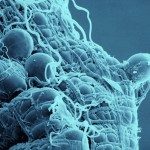Lien vers Pubmed [PMID] – 21422815
RNA Biol 2011 Mar-Apr;8(2):280-6
Recombination is an evolutionary mechanism intrinsic to the evolution of many RNA viruses. In retroviruses and notably in the case of HIV, recombination is so frequent that it can be considered as part of its mode of replication. This process not only plays a central role in shaping HIV genetic diversity worldwide, but has also been involved in immune escape and development of resistance to antiviral treatments. Recombination does not create new mutations in the existing genetic repertoire of the virus, but creates new combinations of pre-existing polymorphisms. The simultaneous insertion of multiple substitutions in a single replication cycle leaves little room for the progressive coevolution of regions of proteins, RNA or, more in general, genomes, to accommodate these drastic sequence changes. Therefore, recombination, while allowing the virus to rapidly explore larger sequence space than the slow accumulation of point mutations, also runs the risk of generating non functional viruses. Recombination is the consequence of a switch in the template used during reverse transcription and is promoted by the presence of structured regions in the genomic RNA template. In this review, we discuss new observations suggesting that the distribution of RNA structures along the HIV genome may enhance recombination rates in regions where the resultant progeny is less likely to be impaired, and could therefore maximize the evolutionary value of this source of genetic diversity.

